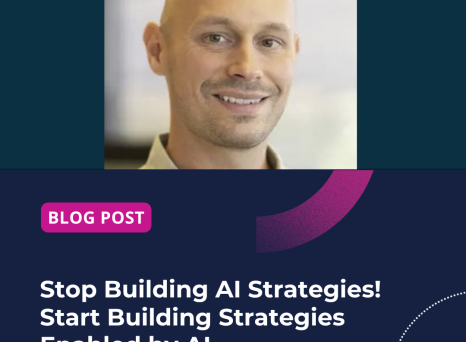Unexpected weather is more than a personal inconvenience, like missing an umbrella for a rainy walk home. High winds and fog can ground flights. Ships can lose cargo overboard in storms.
Unexpected weather is more than a personal inconvenience, like missing an umbrella for a rainy walk home. High winds and fog can ground flights. Ships can lose cargo overboard in storms. Retailers can also miss revenue in unseasonably warm, dry weather if they don’t have the right stock levels for outdoor leisure. Thankfully, we have meteorologists and weather forecasts to help us anticipate and prepare for events like these.
Similarly, forecasting is one of the project management office’s (PMO) most valuable tools for anticipating risks and opportunities and improving project return on investment (ROI). Fundamentally, using historical data to plan project elements such as completion dates, budget, and risk is a sound approach. But, traditional project forecasting is often vulnerable to stakeholder biases and outdated insights. That’s because it’s a manual process that relies, at least in part, on human intuition.
These factors can impact the accuracy of your project forecast, compromising your ROI. It’s also difficult to scale and enhance accurate forecasting without a significant investment in highly skilled human resources. That’s where artificial intelligence (AI) predictive analytics (or predictive AI analytics) comes in.
Read on to understand how predictive AI analytics can improve your organization’s forecasting, boost project success, and drive strategic value.
What is Predictive AI Analytics?
Predictive analytics are technologies that use predictive modeling. This is a statistical technique for analyzing historical project data and predicting outcomes for projects with similar drivers or parameters. Your organization may already have predictive analytics as a function of business intelligence (BI).
With the advent of advanced and commercially viable AI, predictive AI analytics can accelerate this process, improve its accuracy, and scale its impact. Some businesses will build their predictive analysis models if they have the time and development capabilities. Others will invest in an enterprise-level predictive AI analytics tool to integrate with their existing tech stack.
How Does AI Take Predictive Analytics to the Next Level?
We still need human experts to manage, validate, and enhance the output of predictive AI analytics. But, these technologies can augment existing capabilities in 3 key areas:
- Faster Trend and Pattern Recognition. An experienced team of data scientists and analysts can deliver predictive analysis using programming languages such as Python and BI tools such as SQL. But, AI is much quicker at accurately recognizing trends and patterns in data sets. This offers a significant advantage to the PMO, particularly if they work in a sector such as FMCG, where agility is crucial to keep up with consumer preferences and demand.
- Data Analysis at Scale. As long as your data is relevant and reliable, you can forecast more accurately the more data you include in the analysis. AI can analyze very large and diverse volumes of data faster and use fewer resources than a human team. This can make it easier for organizations to improve their forecasting accuracy without compromising the ROI of their BI function with extensive recruitment.
- Real-Time Performance Monitoring. Forecasting is typically an early-phase process in the project lifecycle. But, with factors such as interest rates and geopolitical events leading to fluctuating labor and supply chain costs, early forecasts can quickly become unreliable. PMOs can use predictive AI analytics to monitor live data streams and flag changes that impact the forecast.
Benefits of Predictive AI Analytics for the PMO
Most research estimates of project success rates are outdated and highly variable—from 0.5% in infrastructure projects to 35% in software development. Nevertheless, these figures represent the scale of the challenge facing PMOs in securing ROI for their organization’s projects and portfolios.
To see improvements in their project success rates, PMOs need their very own “meteorologist” to anticipate opportunities and threats and recommend how to prepare. That’s the value of predictive AI analytics. Its benefits for stimulating project success rates include:
- Agile, Data-Backed Decision-Making. Human intuition based on years of experience is still a highly valuable asset for any business. What few people have experienced, however, is the unprecedented convergence of global events we’re currently facing. This includes the climate crisis, geopolitical conflict, and the proliferation of AI itself. Using up-to-date data sources, predictive AI analytics can identify emerging trends within the context of overall project or portfolio history. This supports more agile decision-making that is still backed by data.
- Risk Identification and Prevention. Seasoned project managers (PMs) and PMO leaders will know the risks that commonly impact project success rates. But, identifying and estimating the impact of all risks on a project takes time. This doesn’t align with the faster pace of project delivery most businesses need to achieve today to stay competitive. Predictive AI analytics can compute more risks in less time when you give it access to the right data. In some predictive AI analytics tools, PMs and PMOs can get alerts if new risks appear or minor risks are escalating throughout the project.
- Optimized Resource Allocation. Making the most of your existing resources is critical for many PMOs as they navigate squeezed budgets during economic uncertainty. Predictive AI analytics can use historical project data to identify the resources that a project with specific drivers needs to succeed. This improves project success rates and maximizes ROI, but it can also help reduce waste from resource allocation.
- Cost-Saving Opportunities. Effective cost control can make or break a project’s ROI, particularly in project controls and engineering. You’re often managing highly complex deliverables and multiple tiers of suppliers, which makes it challenging to maintain visibility and monitor costs. PMOs can use predictive AI analytics to live-track actual costs and set up alerts if costs are trending above the budget.
Beyond the Future of Forecasting
Predictive AI analytics is far from the only AI application that can benefit the PMO and help it achieve its goals. And it may be easier to implement than you think. PPM and SPM tools like Planisware, for example, offer these AI-enabled features:
- Generative AI that speeds up the creation of work breakdown structures (WBS), project schedules, and initial risk lists for project planning.
- Chatbots that use natural language processing (NLP) to support user adoption of your PPM or SPM tool and automate project information retrieval.
- Anomaly detection that automatically flags potential data issues, helping to improve data quality over time.
- Particle swarm optimization (PSO) to help balance portfolios and resources for optimal asset use while considering constraints and objectives.


